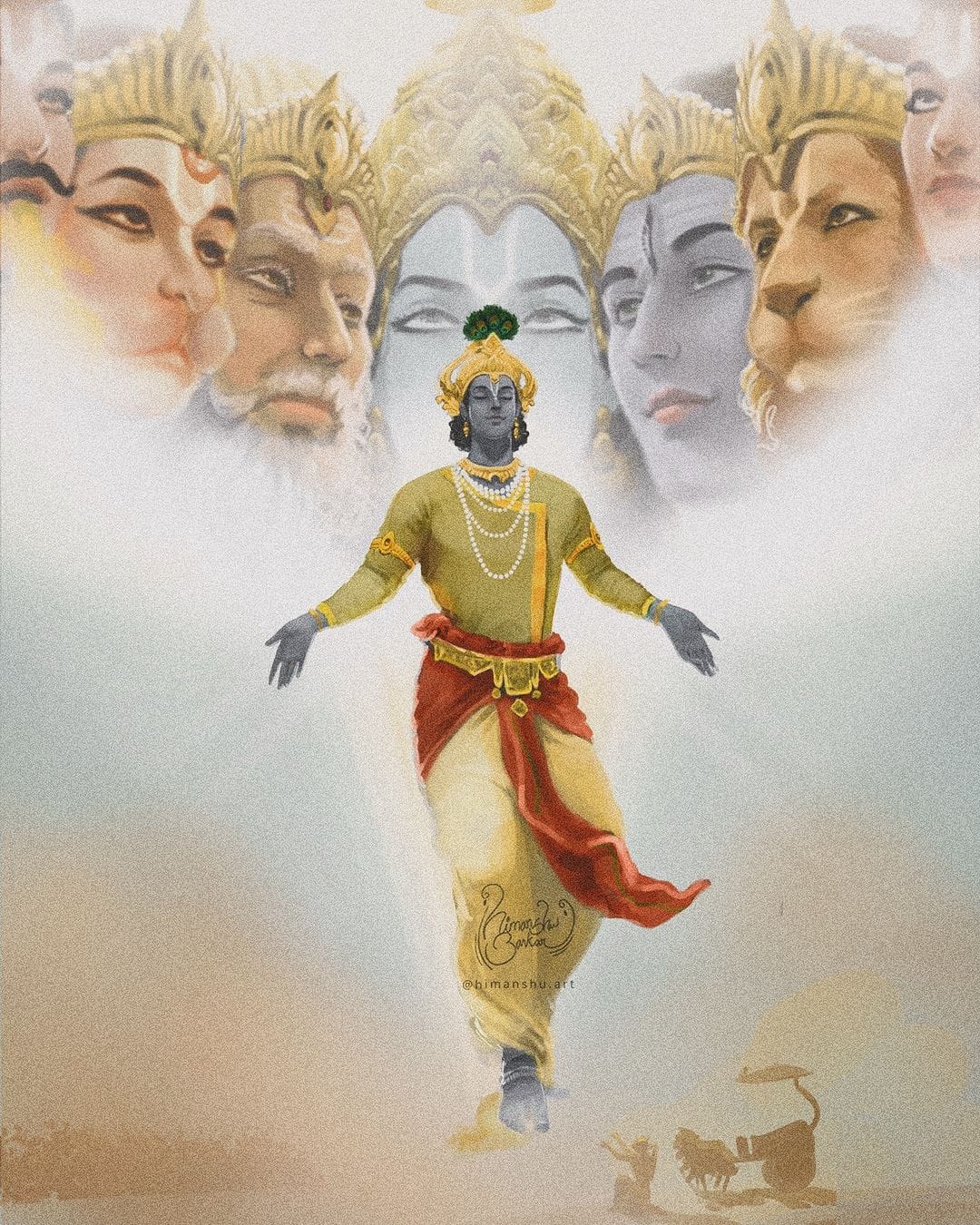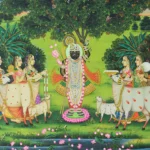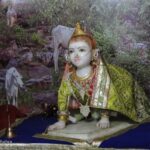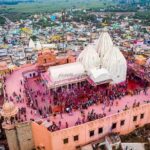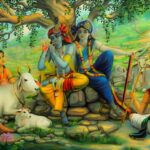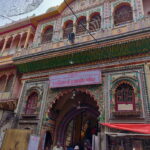
The birth anniversary of Lord Shri Krishna is celebrated with great pomp. Lakhs of devotees from India and abroad gather at the Krishna Janmabhoomi and observe fast throughout the day. Men, women and children perform Abhishek in the temples at 12 o’clock in the night and take Panchamrit. Apart from Krishna’s birthplace, grand events are organized in Dwarka, Bihariji and all other temples, which attract huge crowds.
Festival of Lord Krishna’s appearance
- It was Lord Shri Krishna who gave Arjun the divine message of moving from cowardice to bravery, from sadness to prasad, through Shrimad Bhagavad Gita.
- Danced on the hood of Kaliya serpent, ate the greens of Vidurani and lifted Govardhan mountain and became known as Giridhari.
- When the time came, he got Duryodhana’s thigh attacked by Bheema, listened to Shishupala’s abuses, but when he got angry, he also raised Sudarshan Chakra.
- By becoming Arjun’s charioteer, he led the Pandavas to victory in the battle of Mahabharata.
- It was Lord Shri Krishna, who was full of sixteen arts, who ate the raw rice from the bundle of poor Sudama for the maintenance of Mitra Dharma and in return gave him the kingdom.
- The birth anniversary of the most merciful Lord is celebrated as Janmashtami.
Lord Shri Krishna is considered to be the eighth incarnation of Lord Vishnu. This is the grandest incarnation of Shri Vishnu complete with sixteen arts. Shri Ram was incarnated as a prince in the house of King Dasharatha, while Shri Krishna appeared in the prison of the tyrant Kansa. Shri Krishna was born on the midnight of Bhadrapada Krishna Ashtami in Rohini Nakshatra as the son of Devaki and Shrivasudev. Fearing his death, Kansa had imprisoned his sister Devaki and Vasudev in prison.

It was raining heavily at the time of Krishna’s birth. There was dense darkness all around. As soon as Shri Krishna descended, the chains of Vasudev and Devaki were removed, the doors of the prison opened themselves, the guards fell into deep sleep. Vasudev somehow took Shri Krishna across the swollen Yamuna to the house of his friend Nandagop in Gokul. There, Nand’s wife Yashoda also gave birth to a daughter. Vasudev made Shri Krishna sleep near Yashoda and took that girl away. Kansa wanted to kill that girl by throwing her. But he failed in this task. Shri Krishna was brought up by Yashoda and Nand. In his childhood itself, Shri Krishna killed many demons sent by his maternal uncle and foiled all his evil attempts. In the end, Shri Krishna killed the oncoming Kansa. The name of the birth anniversary of Shri Krishna is Janmashtami. This festival is celebrated in Gokul by the name of ‘Gokulashtami’.
as per the scriptures
Krishna Janmashtami or Janmashtami fast and festival is prevalent on the Ashtami of Shravan (Amant) Krishna Paksha, which is celebrated everywhere in India and is considered the best among all the fasts and festivals. It is mentioned in some Puranas that it is celebrated on Ashtami of Krishna Paksha of Bhadrapada. Its explanation is as follows, ‘In the mythological texts, the month is Purnimanta and among these months, Krishna Paksha is the first Paksha.’ There is specific mention of the greatness of Krishna Janmashtami in Padma Purana, Matsya Purana, Agni Purana.

- It is mentioned in Chandogyopanishad that Krishna Devaki’s son received teachings from Ghor Aangir. There was a Vedic poet named Krishna, who prayed to the Ashvins.
- The index has considered the Rigveda to be that of Krishna Angiras.
- In Jain traditions, Krishna is considered to be a contemporary of the 22nd Tirthankara Neminath and in the description of 63 great men of Jain pre-history, about one third of the part is in relation to Krishna.
- Krishna’s life is full in Mahabharata. In the Mahabharata, he has been called a Yadav prince, he was the closest friend of the Pandavas, a great warrior, a politician and a philosopher. At some places he is considered God and is called Vishnu himself. Mahabharata Peace Festival; Drona festival; Karna Parva; Forest festival; Bhishma festival. Yudhishthir, Draupadi and Bhishma have sung praises of Krishna. Harivansh, Vishnu, Vayu, Bhagwat and Brahmavaivarta Purana describe Krishna’s pastimes which are not found in Mahabharata.
- It is revealed from Panini that during his time some people were also ‘Vasudevaka’ and ‘Arjunaka’, which means devotees of Vasudeva and Arjun respectively.

- In the verses of Patanjali’s Mahabhasya, there are indications towards persons and events related to Krishna, such as the names of Kansa and Bali in Vartika Samhita; ‘Govind’ in Vartika Samhita; And Vasudeva and Krishna in Panini’s Vartika. In Patanjali, ‘Satybhama’ has also been called ‘Bhama’. In ‘Vasudevavargya, Rishyandhakvrishnikurubhyascha’, Ugrasena has been called Andhaka and Vasudeva and Baladev have been called Vishnu, etc.
- Most scholars date Patanjali to B.C. It is believed to be from the second century. Krishna stories are much earlier than this. In Aadi Parva and Sabha Parva, Krishna has been called Vasudev and Parambrahma and the origin of the world.
- B.C. In the Ghosundi inscription and Indian antiquary of the second or first century, Krishna has been called ‘Bhagwat and Sarveshwar’. The same thing is mentioned in the Nagaghat inscriptions, B.C. Also in 200 AD. In the ‘Garunadhwaj’ inscription of Besnagar, Vasudev has been called ‘Dev-Dev’. This evidence proves that B.C. The worship of Vasudeva was prevalent in northern and central India around 500.
- Shri R. Yes. ‘Vaishnavism, Shaivism’ written by Bhandarkar, where a discussion has been presented about the Vaishnav sect and its antiquity. It is surprising that the medieval texts written on Krishna Janmashtami have taken quotes from Bhavishya, Bhavishyapottara, Skanda, Vishnudharmottara, Naradiya and Brahma Vaivarta Puranas, but they have left untouched the Bhagavata Purana which is the ‘Veda’ of the later, medieval and present day Vaishnavas. ‘ It is believed. The description of Krishna’s birth in Bhagwat is doubtful and ordinary. It happened there that the time was full of all qualities and beautiful, the directions were clear and the sky was clear and full of air, the air was pleasant and fragrant and when Janardan was born from the womb of Devaki, it was midnight and darkness had covered everything.
- In the Bhavishya Purana, Krishna himself has said to Yudhishthira about the ‘Krishna Janmashtami fast’ – ‘I was born to Vasudev and Devaki on Bhadra Krishna Ashtami, when the Sun was in Leo, the Moon was in Taurus and the constellation was Rohini. When Rohini Nakshatra occurs on the Ashtami of Krishna Paksha of Shravan, then that date is called Jayanti, by fasting on that day, all the sins committed in childhood, youth, old age and many previous births are removed. The result of this is that if Rohini is found on the Ashtami of Krishna Paksha of Shravan, then not only is it Janmashtami, but when Rohini is combined with Krishna Ashtami of Shravan, then it is Jayanti.
Janmashtami fast and Jayanti fast

Are ‘Janmashtami Vrat’ and ‘Jayanti Vrat’ the same or are they two separate fasts. Kalnirnaya has considered both of them as separate fasts, because two separate names have come, the reasons (occasions) for both are different (the first is Ashtami of Krishna Paksha and the second is Ashtami of Krishna Paksha combined with Rohini), the characteristics of both are different, because Janmashtami. There are provisions for fasting in the scriptures and in the Jayanti Vrat, there are provisions for fasting, charity etc. Apart from this, the Janmashtami fast is daily (because not observing it is said to result in sin only) and the Jayanti fast is both daily and lustful, because not only does it not involve sin, but observing it results in attainment of fruit. It has also been said. There are separate mentions of both in the same verse. Hemadri, Madanaratna, Niranayasindhu etc. have considered both to be different. Niyansindhu has also said that during this period people observe Janmashtami fast and not Jayanti fast. But Jayanti Nirnaya says that people celebrate Jayanti and not Janmashtami. Probably this difference is between North and South India. There are two contradictory things in Varaha Purana and Harivansh. According to the first, Krishna was born on Ashadh Shukla Dwadashi. According to Harivansh, at the time of Krishna’s birth, Abhijit Nakshatra was there and it was Vijay Muhurta. Perhaps these sayings have the imprint of ancient traditions. In the medieval essays, there is some discussion about the date and time of observance of Janmashtami fast; kriyatattva; Date element. Conclusions on this subject have been given in Samaymayukh and Nirjan Sindhu.
Timing to celebrate Janmashtami
It is clear from all the Puranas and texts related to Janmashtami that the main time for the celebration of Krishnajanma is ‘midnight of the Ashtami of Shravan Krishna Paksha’ (if it is Purnimant then it is done in Bhadrapada month). This date is of two types –
- Without Rohini Nakshatra and
- The one with Rohini Nakshatra.

- There are 18 types in Niryanamrit, of which 8 are Shuddha Tithis, 8 are Viddha and 2 others (one of which is at midnight with Rohini Nakshatra and the other is on Navami, Mercury or Mars with Rohini). *The brief decision from Tithitatva is as follows – ‘If ‘Jayanti’ (Rohini Yukt Ashtami) is of one day, then one should fast on that day, if there is no Jayanti then it should be on Rohini Yukt Ashtami, if there are two days with Rohini then Fasting is done only on the second day, if there is no Rohini Nakshatra then the fast should be done on Ashtami situated at midnight or if Ashtami is of two days at midnight or if it is not at midnight then the fast should be done on the second day. If the birth anniversary is on Mercury or Mars, then fasting is a great virtue and is considered superior to millions of fasts. The person who fasts on the birth anniversary associated with Mercury or Mars, gets freed from birth and death forever.’
Major acts and rituals during Janmashtami fast
The main activities in Janmashtami fast are fasting, Krishna puja, Jagran (night vigil, recitation of stotras and listening to stories related to Krishna’s life) and Parana.
Tithi Tatva Samaymayukh, Kaal Tatva Vivek, Vratraj, Dharmasindhu have presented long discussions on Janmashtami fasting method on the basis of Bhavishyapotra Purana.Tithi Tatva Samaymayukh, Kaal Tatva Vivek, Vratraj, Dharmasindhu have presented long discussions on Janmashtami fasting method on the basis of Bhavishyapotra Purana.
fasting method

On the day of fast, in the morning, the fasting person should pray to Sun, Som (Moon), Yama, Kaal, both Sandhyas (morning and evening), five ghosts, day, Kshapa (night), wind, dikpalas, land, sky, Khacharas (wind directions). Residents) and gods should be invoked so that they are present. He should keep a copper vessel full of water in his hand, which has some fruits, flowers, intact and should take the name of the month etc. and should make a resolution – ‘I will observe Krishna Janmashtami fast to get some specific fruits etc. and to get rid of my sins.’ Then he addresses Vasudev and recites four mantras, after which he pours water into the vessel. He should build a maternity home for Devaki to give birth to a son, in which auspicious vessels filled with water, water basin, flower garlands etc. should be kept, agarwood should be burnt and decorated with auspicious things and Shashthi Devi should be kept. Pictures of Gods and Gandharvas (with joined hands), Vasudeva (with sword in hand), Devaki, Nand, Yashoda, Gopis, Kansa-protectors, Yamuna River, Kaliya Naga and Gokul should be made around the house or its walls. Pictures etc. related to the events should be made. A bed with curtains should be prepared in the maternity home.
determination and determination
The fasting person should take a bath in a river (or pond or anywhere) with sesame seeds in the afternoon and make a resolution – ‘I will worship Krishna along with his companions.’ He should make an idol of Krishna made of gold or silver, touch the cheeks of the idol and consecrate it with mantras. He should meditate on Devaki and her child Shri Krishna with mantras and worship Vasudev, Devaki, Nanda, Yashoda, Baldev and Chandika with bath, incense, smell, naivedya etc. and with mantras. Then he should perform caste ceremony, navel piercing, Shashthi puja and naming ceremony etc. with a symbolic cover. Then at the time of moonrise (or a little after midnight) Ardhya should be offered on some altar, this Ardhya can also be offered to the moon with Rohini, in Ardhya water is offered from the conch, in which flowers, flowers and sandalwood paste are kept. Are. All this happens with a mantra. After this, the devotee should pay obeisance to the moon and bow down in prostration and should recite verses containing different names of Vasudev and finally offer prayers.
Night vigil and morning worship
The fasting person should remain engaged in chanting hymns, mythological stories, songs and dances in praise of Krishna throughout the night. On the next day, after performing the morning rituals, the idol of Krishna should be worshipped, food should be given to Brahmins, gold, cow, clothes should be donated, with the words ‘May Krishna be pleased with me’. Him
यं देवं देवकी देवी वसुदेवादजीजनत्।
भौमस्य ब्रह्मणों गुप्त्यै तस्मै ब्रह्मात्मने नम:।।
सुजन्म-वासुदेवाय गोब्राह्मणहिताय च।
शान्तिरस्तु शिव चास्तु॥
Should be recited and the Krishna idol should be given to a Brahmin and after performing Parana, the fast should be ended. For the differences in the method, it has been said in Dharmasindhu that Shudras should give up Vedic mantras, but they can edit mythological mantras and songs. There is no clear indication of the use of Vedic mantras in ‘Samaymayukh’ and ‘Tithitatva’.
- In the medieval essays, discussion has been raised about the main purpose of Janmashtami fast. According to some people, both fasting and worship are important.
- After explanation, Samaymayukh has concluded that fasting is only a ‘part’, but worship is the main one. But Tihitattva has said on the basis of Bhavishya Purana and Mimamsa principles that fasting is the main thing and worship is only a ‘part’ i.e. only a supporting element.
Difference between Udyapan and Parana
After Parana, the devotee recites the mantra ‘Om Bhootaye Bhooteshwaray Bhootapatye Bhootasambhavay Govindaya Namo Namah’. In some circumstances, Parana also takes place at night, especially among Vaishnavas, who observe the fast in the daily form and not in the Kamya form. There is a difference in the meanings of ‘Udyapan and Paran’. Fasts like Ekadashi and Janmashtami are observed throughout life. In them, whenever a fast is observed, Parana occurs, but when someone observes the fast only for a limited period and ends it, then the last act of its completion is Udyapan.
Sri Krishna Janmashtami Festival

- Devotees across the country celebrate Janmashtami as a great festival in a grand manner.
- Very beautiful festivals are celebrated in all Krishna temples.
- Especially these festivals take place in the temples of Vrindavan, Mathura (Uttar Pradesh), Dwarka (Gujarat), Guruvayoor (Kerala), Udripi (Karnataka) and ISKCON.
- The festival of Shri Krishna Janmashtami is celebrated all over the world, in every house and in every temple.
- Most of the people observe fast and consume ‘Panchamrit or fruit’ only at twelve o’clock in the night.
- A special event is organized in the birthplace of Mathura. The ride is taken out. On the second day, during Nandotsav, Dadhikando is held in temples.
- Fruits, sweets, clothes, utensils, toys and money are looted. Which almost all the devotees loot and get blessed.
- Shri Krishna Janmashtami is celebrated with great pomp and show in Gokul, Nandgaon, Vrindavan etc.
Chabile’s Chhappan Bhog

Shri Krishna lived a lifetime of happiness and luxury, that is why Janmashtami is celebrated in such a grand manner. Many types of sweets are made on this day. Like laddu, chakli, payasam (kheer) etc. Apart from this, dishes made from milk, especially butter (which was the favorite food of Shri Krishna during his childhood), are offered to Shri Krishna. Various types of fruits are also offered. But almost all people consider it best to make laddu or kheer and offer it to Shri Krishna. Food of various types is prepared and dedicated to Lord Krishna.
Grand decoration of Lord Krishna’s idol

In the puja room where the idol of Lord Krishna is placed, rangoli of attractive colors is painted. This rangoli is made from ‘paddy straw’. From the door frame of the house to the puja room, pictures of small feet are made with this material. These symbolic signs indicate the arrival of Lord Shri Krishna. Earthen lamps are lit and placed in front of the house. Child Shri Krishna is also kept in a swing. The entire place of worship is decorated with flowers.
midnight worship rituals
On the occasion of Janmashtami, temples are beautifully decorated and prayers are offered at midnight. An idol of Shri Krishna is made and placed in a cradle and shaken slowly. People sing bhajans and aarti is performed throughout the night. The whole day’s fast is concluded after Aarti and offering food to Balkrishna.
Janmashtami Festival in Brajbhoomi

- Brajbhoomi Mahotsav is unique and amazing.
- Mathura itself is considered to be the holiest place, and in Mathura too there is a beautiful temple in which it is believed that this is the place where Shri Krishna was born.
- It is estimated that more than seven lakh devotees from Mathura and surrounding areas come to worship at this place.
Shri Krishna Janmabhoomi Temple
- This temple is the main attraction center for devotees.
- Hundreds of devotees can see and hear the powerful sermons from every corner of the temple with the help of closed circuit TV.
- Many people camp in the temple since daybreak, so that they can witness the midnight birth ceremony.
- It is midnight, all the devotees say in a loud voice – Jai to Lord Krishna.
- The small idol is covered with a white cloth and kept at a high place, so that all the devotees can have darshan.
Dahi-Handi Ceremony
In this, curd, butter, honey, fruits etc. are kept in an earthen vessel. This vessel is hung 30 – 40 feet above the ground. Young boys and girls participate in ceremonies to receive this award. To do this, young men climb on each other’s shoulders and form a pyramid. Due to which a person can easily break the vessel and get the contents kept in it. Usually a string of rupees is tied with a rope. That vessel is also tied with this rope. This amount is distributed among all the associates who participate in that human pyramid.
Krishnavatar
Every Indian is familiar with the ‘story of Shri Krishnaavatar’ written in Bhagwat Purana. Shri Krishna’s childhood mischiefs like stealing butter and curd, his fights with shepherds and cowherds, various types of games, his stubbornness against Indra (in which he lifted Govardhan mountain on his finger, so that the people of Gokul would be saved from excessive rain) The battle with the most poisonous snake Kalia and the dance on its thousand hoods, the sound of his alluring flute, the destruction of the spies sent by Kansa – all these incidents are emotion-oriented and very interesting.
centers of faith

Shri Krishna has been the center of our faith for ages. Sometimes he is the son of Mother Yashoda, sometimes he is the mischievous Kanha of Braj, sometimes he is a prankster stealing the peace of the Gopis, sometimes he comes forward accepting the hospitality of a widower’s wife and sometimes he comes forward giving the knowledge of Geeta to Arjun. Krishna has many forms and is complete in every form. For the sake of his devotee, he cheerfully accepts the curse of Gandhari.
Srimad Bhagavad Geeta
As the protector of the Pandavas, the charioteer of Arjuna’s chariot in the Kurukshetra war, the generosity of Shri Krishna and his divine message are eternal and suitable for all ages. This divine message given by Shri Krishna to the grieving and distraught Arjun is written in the Geeta. Bhagavad Gita begins with this verse ‘Dharmakshetre Kurukshetre Samveta Yuyutsavah’. Geeta is the basis text for explaining and understanding human psychology. There are two poles of our culture – one is Shri Ram and the other pole is Shri Krishna. Ram is exemplary and Krishna is worth thinking about. Indian thinking says that wherever there is life on earth, it is the incarnation of Vishnu. All the images are of Mahesh of Mahakaal, and all the situations that are eager to take birth are of Brahma. These are the three ways of manifestation of energy; if we want, we can also call this entire subject as the holy ‘Trimurti’.
confluence of joy
Lord Krishna had given the knowledge of this supreme element to the desperate Arjuna in the field of Kurukshetra five thousand years ago. Geeta is the emotional heart book of Shri Krishna. The blue light that is present in this entire universe and the continuous sound that is heard is the lineage of Shri Krishna. He is considered to be the confluence of Sat-Chit-Bliss, Sat is present everywhere, Chit is silent and bliss is hidden, just as butter is hidden in milk, in the same way a person who takes refuge in Shri Krishna becomes thrilled with bliss. Krishna also has such a compassionate heart that if you call him while drowning, he responds within a moment. Shri Krishna is also ‘Raseshwar’ and also ‘Yogeshwar’.

Krishna, who is in danger of being killed even before he is born. Dark night, within the prison, the birth of a child, who is separated from his mother immediately after birth. Six days after birth, Putna (Putna means woman opposing the son) tries to kill the one whose flowers are poisonous.
public hero
Mathura city was ruled by Kansa. Kansa had put his father Ugrasen in jail in his greed to grab power. When Krishna saw the people of Mathura giving a part of their earnings to Kansa in the form of milk and curd, he protested against it. The people understood Krishna’s words and stopped supplying food items to Kansa. This is the form of Krishna’s public leader. Kansa was enraged by this obstacle and on the pretext of the Malla war, he planned to call Krishna along with his brother Balram to Mathura and kill them. Krishna must have been twelve years old at that time. Krishna was also extraordinary. He along with his brother (Balram) went to Mathura and killed Kansa and despite favorable circumstances, instead of sitting on the throne himself, he placed Kansa’s father Ugrasen, who was imprisoned in prison, on the throne and then left Vrindavan.
in the plains of Kurukshetra
The great personality of Shri Krishna appears in the plains of Kurukshetra. Krishna had tried to prevent war from happening. Then he accepted the war and took another decision before the war – that my army would fight with Duryodhana. I will remain alone on the side of Pandavas. Only Krishna could have taken such an opposing decision. This is why it is said that Krishna is not an example to be emulated, but a subject to be contemplated. There is a deep symbolism behind every action of his, which is beyond the understanding of the common man.

those who discipline the world
In sharp contrast to the festive and joyous childhood that Krishna lived in Vrindavan, why could the same Krishna say this to Arjuna in Kurukshetra – ‘Kurukarmeva Tasmatvam’ i.e. do the work. Here he is asking Arjun to fight.
beauty in totality
Four efforts have been enumerated here, Dharma, Artha, Kama and Moksha. The explanation of these four is in the first verse of Ishavasyopanishad. The word ‘Ish’ is made from the metal ‘Brick’. This means that the one who disciplines everyone or has authority over everyone is God. To not believe him is to deny even yourself. The one who does not know himself does not believe in God either. We all know this mantra of Ishavasya Upanishad, ‘Aspire to live for a hundred years while doing your work’. In this mantra ‘Ishavasyamind Sarvam’, three things have been said for three efforts.
- For the effort of salvation: ‘ईशावास्यमिंद सर्वम्।‘
- For sexual effort: ‘तेन त्यक्तेन भुंजीथा:।‘
- For the meaning of effort: ‘मागृध: कस्यस्विद् धनम्॥‘
- And for the fourth effort called Dharma: कुर्वन्नेवीह कर्माणि
Krishna is talking about karma and at the same time he is also saying – ‘Sarvdharmaan Parityajya’, leaving aside all the religions i.e. the religion of the father, the son, and crossing all the limits of all physical, worldly or materialistic, divine attachments and diseases, I Come and take refuge in Him who is the creator and sustainer of all. Then you will attain the supreme state, free from all sins.

